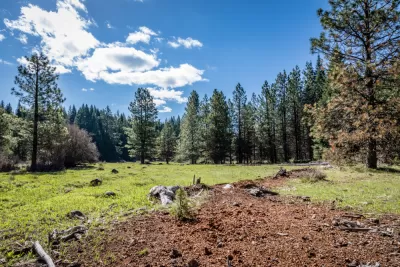The ecosystems of Oregon’s Coast Range are some of the most adept ecosystems for absorbing carbon in the entire country. The same trees that absorb that carbon can be turned into a major source of emissions in the hands of humans.

Carl Segerstrom reports on a surprising environmental dynamic at work in Oregon, revealed by a recent study authored by researchers at Oregon State University and the University of Idaho.
Less than a year after devastating fires ripped through some of the most beautiful areas in the state, a study published by the Proceedings of the National Academy of Sciences of the United States of America (PNAS) finds that logging and wood products are a larger source of carbon emissions in Oregon's forests than fires.
"Figuring out the role of forests and wood in carbon pollution could have major policy implications in Oregon, as Gov. Kate Brown has pledged to meet the emissions goals of the Paris Climate accords," according to Segerstrom.
Not only are fires a smaller source of carbon emissions, but "the wood products industry is the largest sector contributing to carbon pollution in the state," according to the study, as explained by Segerstrom.
"Wood product emissions are the result of fuel burned by logging equipment, the hauling of timber, milling, wood burned during forestry activities, and the ongoing decomposition of trees after they are cut," explains Segerstrom.
The researchers responsible for the study will next expand the concept to a larger swath of the Western United States.
FULL STORY: Timber is Oregon’s biggest carbon polluter

Alabama: Trump Terminates Settlements for Black Communities Harmed By Raw Sewage
Trump deemed the landmark civil rights agreement “illegal DEI and environmental justice policy.”

Study: Maui’s Plan to Convert Vacation Rentals to Long-Term Housing Could Cause Nearly $1 Billion Economic Loss
The plan would reduce visitor accommodation by 25% resulting in 1,900 jobs lost.

Planetizen Federal Action Tracker
A weekly monitor of how Trump’s orders and actions are impacting planners and planning in America.

Waymo Gets Permission to Map SF’s Market Street
If allowed to operate on the traffic-restricted street, Waymo’s autonomous taxis would have a leg up over ride-hailing competitors — and counter the city’s efforts to grow bike and pedestrian on the thoroughfare.

Parklet Symposium Highlights the Success of Shared Spaces
Parklets got a boost during the Covid-19 pandemic, when the concept was translated to outdoor dining programs that offered restaurants a lifeline during the shutdown.

Federal Homelessness Agency Places Entire Staff on Leave
The U.S. Interagency Council on Homelessness is the only federal agency dedicated to preventing and ending homelessness.
Urban Design for Planners 1: Software Tools
This six-course series explores essential urban design concepts using open source software and equips planners with the tools they need to participate fully in the urban design process.
Planning for Universal Design
Learn the tools for implementing Universal Design in planning regulations.
Caltrans
Smith Gee Studio
Institute for Housing and Urban Development Studies (IHS)
City of Grandview
Harvard GSD Executive Education
Toledo-Lucas County Plan Commissions
Salt Lake City
NYU Wagner Graduate School of Public Service





























